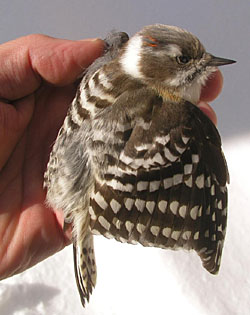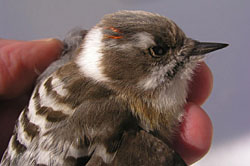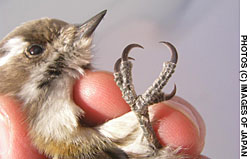What's making a noise in the woods?
By Mark Brazil | Mar 15, 2006
WOODPECKERSThe cherry blossom wave has begun its annual northward sweep through the country, island-hopping up the archipelago from Okinawa in the wake of the delicately blossoming plum.
As those fragile tree blossoms presage spring, so various resident birds, fine-tuned to the subtly lengthening hours of sunlight and shortening nights, proclaim their newly occupied territories and summon mates with their first tentative songs of the year.
Last month, on a visit to strangely green Kyushu (strange to me, as my Hokkaido home has been under its white winter blanket since mid-December), I wandered among low-trimmed and geometrically arranged tea plantations flanked by white-blossomed plum trees. There, in that beautiful setting, I heard the first hesitant song of a Japanese bush warbler, a bird I won’t hear in Hokkaido for at least another six weeks. While the bush warbler seemed unsure of its right to declare itself, a nearby bull-headed shrike chattered demonstratively and in no uncertain tone, clearly and loudly confident of its territory with a female already in tow.
Despite the still wintry conditions in Hokkaido, even among our northernmost species some are surprisingly early nesters. Already the Blakiston’s fish owls I wrote about in my January column are incubating; I watched a pair courting and mating just before the end of February. In the same week I also came across a pair of white-tailed eagles in their nest, the female apparently sitting on eggs. While these large raptors are exceptionally early breeders, stealing a march on the year before winter has even faded, among our smaller resident birds others also get busy along with the first hint of weakening winter weather.
Upsurge of sound
During late February and early March, there is a steady upsurge of sound in the deciduous woods that are to be found from central Honshu northward. Dry tapping, and hard, rattling sounds indicate this is a good season to observe woodpeckers. These supremely adapted birds can make a dry branch or tree limb resonate and reverberate like a sounding box, so that their territorial din carries far through the still leafless forests.
Once, years ago when I lived in Scotland, I traced one that had learned to drum on the metal cap of a wooden telephone pole, making its territorial noise sound more like a machine-gun rattle than something created by a bird. The reverberating, drumming sounds of woodpeckers carry far in the forest, but the birds usually stay still while producing them, making it possible to track them down as the leafless branches do little to obscure them.
Our commonest loud forest drummer is the great spotted woodpecker, a boldly pied bird sporting a bright red patch on the vent, and in the male also on the back of the head. The larger white-backed woodpecker also drums loudly, but is scarcer, and so is less frequently encountered.
Like most of their extensive tribe, these birds use their specialized chisel-shaped bills to flake off bark, and excavate into exposed wood in search of insect larvae. One of Hokkaido’s many woodpeckers, the enormous, crow-sized, black woodpecker, is renowned for being so powerful that it can hack deep into the trunks of living trees, and I have found excavations so great that I could poke my hand in all the way to my wrist.
The black woodpecker commonly forages low on tree trunks, within a meter or so of the ground, but I recall one winter when I was able to sneak up beneath one bird that had taken a position high on a moribund conifer. It was engrossed in its hammering, and a rain of bark, wood chunks and chips was falling down around the bole and covering the surface of the snow as I quietly approached. Eventually, I crept right up to the tree, placed my ear against the trunk and listened to the deep, heavy “thonk-thonk-thonk” sounds reverberating down the snag so deeply and powerfully that they seemed like the last heartbeats of the dying tree.
Whereas the enormous black woodpecker is found only in Hokkaido, at the opposite end of the scale Japan is also home to a diminutive member of the family. Weighing a mere 18-26 grams, and measuring just 15 cm in length, the Japanese pygmy woodpecker is the smallest member of the family in Japan. Though territorial and often solitary during spring to autumn, it commonly joins mixed-species flocks in winter, when its distinctive, rather gently buzzing “kzzzz-kzzzz” calls are a welcome addition to the harsher sounds of the more demonstrative great tit, varied tit and nuthatch that commonly comprise such flocks.
Where the larger woodpeckers sport bills like chisels, the Japanese pygmy woodpecker has a more needle-like beak — and, not surprisingly, its habits are different too. Unable to hack and chisel into hard wood, this tiny bird creeps in spirals, mouse-like, around the lower trunks and limbs of deciduous trees, pausing to flake and prize away loose bark to expose insect eggs and larvae beneath. Occasionally, you will hear a thin, dry rattle that sounds more like a pen nib being irritably tapped on dry paper than the normal drumming sound of a woodpecker. More often heard are the buzzy “khy, khy, khy, khy’ calls with which they declare their territorial occupancy over long distances rather than by drumming.
When the light glints
Camouflaged with horizontal gray-brown and white bars across their back and wings, and with dusky stripes down their chests and flanks, these small woodpeckers can easily be missed as they forage through the forest, though their regular buzzing call is a giveaway.
All of our woodpecker species sport red feathering, somewhere in their plumage, though in some it is confined only to the male. In a sense, the diminutive pygmy woodpecker is no exception, but despite having watched them hundreds of times, I have only rarely been able to see their red spot. In this species, males have a small red patch toward the rear of the sides of their head, yet you may watch them for years before you see it, and then perhaps only when the wind ruffles their feathers, or when the light just glints from the right angle.
The bird pictured here had stunned itself against a window. When examining it in the hand, not only did I finally realize just how fine the bird’s bill is, but for the first time I was able to examine the red spot in some detail. It turned out that it consists of very few feathers, which are merely tipped with a metallic red sheen — making it is hardly surprising that it is so difficult to see in the field.
From the Nansei Shoto islands (between Kyushu and Taiwan) to northern Hokkaido, this tiny woodpecker survives year-round in a range of climates from frigid to humid, and you will find it in hill and mountain forests, and even in well-wooded suburbs and urban parks. Just now, before the leaves open fully, is a good time of year to locate one.



